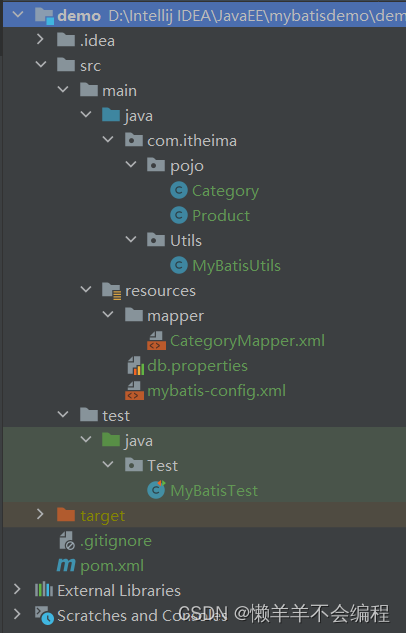【案例介绍】
现有一个商品表product和一个商品类别表category,其中,商品类别表category和商品表product是一对多的关系。商品表product和商品类别表category分别如下所示:
| 商品表(product) | |||
| 商品编号(id) | 商品名称(goodsname) | 商品单价(price) | 商品类别(typeid) |
| 1 | 电视机 | 5000 | 1 |
| 2 | 冰箱 | 4000 | 2 |
| 3 | 空调 | 3000 | 2 |
| 4 | 洗衣机 | 2000 | 2 |
| 商品类别表(category) | |
| 商品类别编号(id) | 商品类别名称(typename) |
| 1 | 黑色家电 |
| 2 | 白色家电 |
本案例具体要求如下:根据商品表和商品类别表在数据库分别创建一个商品表product和商品类别表category,并通过MyBatis查询商品类别为白色家电的商品的所有信息。
【案例实现】

1.数据准备:在MySQL中创建一个名称为mybatis的数据库。
CREATE DATABASE mybatis;①在数据库中创建product表,并插入测试数据:
create table product(
id int primary key auto_increment,
goodsname varchar(20) not null,
price int not null,
typeid int not null
);insert into product values(1,'电视机',5000,1);
insert into product values(2,'冰箱',4000,2);
insert into product values(3,'空调',3000,2);
insert into product values(4,'洗衣机',2000,2);② 在数据库中创建category表,并插入测试数据:
create table category(
id int(32) primary key auto_increment,
typename varchar(40)
);insert into category values(1,'黑色家电');
insert into category values(2,'白色家电');2.引入相关依赖:在项目的pom.xml文件中导入MySQL驱动包、JUnit测试包、MyBatis的核心包等相关依赖。
<?xml version="1.0" encoding="UTF-8"?>
<project xmlns="http://maven.apache.org/POM/4.0.0"
xmlns:xsi="http://www.w3.org/2001/XMLSchema-instance"
xsi:schemaLocation="http://maven.apache.org/POM/4.0.0 http://maven.apache.org/xsd/maven-4.0.0.xsd">
<modelVersion>4.0.0</modelVersion>
<groupId>org.xinhua</groupId>
<artifactId>MyBatisTest</artifactId>
<version>1.0-SNAPSHOT</version>
<properties>
<maven.compiler.source>17</maven.compiler.source>
<maven.compiler.target>17</maven.compiler.target>
<project.build.sourceEncoding>UTF-8</project.build.sourceEncoding>
</properties>
<dependencies>
<dependency>
<groupId>org.mybatis</groupId>
<artifactId>mybatis</artifactId>
<version>3.5.11</version>
</dependency>
<dependency>
<groupId>mysql</groupId>
<artifactId>mysql-connector-java</artifactId>
<version>8.0.28</version>
</dependency>
<dependency>
<groupId>junit</groupId>
<artifactId>junit</artifactId>
<version>4.12</version>
<scope>compile</scope>
</dependency>
</dependencies>
<build>
<resources>
<resource>
<directory>src/main/java</directory>
<includes>
<include>**/*.properties</include>
<include>**/*.xml</include>
</includes>
<filtering>true</filtering>
</resource>
</resources>
</build>
</project>3.POJO类准备:①创建持久化类Product,并在类中定义相关属性和方法。
package com.itheima.pojo;
public class Product {
private int id;
private String goodsname;
private double price;
private int typeid;
public void setId(int id) {
this.id = id;
}
public void setGoodsname(String goodsname) {
this.goodsname = goodsname;
}
public void setPrice(double price) {
this.price = price;
}
public void setTypeid(int typeid) {
this.typeid = typeid;
}
public int getId() {
return id;
}
public String getGoodsname() {
return goodsname;
}
public double getPrice() {
return price;
}
public int getTypeid() {
return typeid;
}
@Override
public String toString(){
return "Product{" + "id=" + id + ",goodsname=" + goodsname +",price=" + price + '}' + '\n';
}
}
②创建持久化类Category,并在类中定义商品类别的相关属性和方法。
package com.itheima.pojo;
import java.util.List;
public class Category {
private Integer id; //主键id
private String typename; //类别名称
private List<Product> productList; //商品集合
public void setId(Integer id) {
this.id = id;
}
public void setTypename(String typename) {
this.typename = typename;
}
public void setProductList(List<Product> productList) {
this.productList = productList;
}
public Integer getId() {
return id;
}
public String getTypename() {
return typename;
}
public List<Product> getProductList() {
return productList;
}
@Override
public String toString(){
return "Category{" + "id=" + id + ",typename=" + typename + ",productList=" + productList + '}' ;
}
}4.创建映射文件CategoryMapper.xml:在文件中编写一对多关联映射查询的配置,该文件主要用于配置SQL语句和Java对象之间的映射 。
<?xml version="1.0" encoding="UTF-8" ?>
<!DOCTYPE mapper
PUBLIC "-//mybatis.org//DTD mapper 3.0//EN"
"http://myBatis.org/dtd/mybatis-3-mapper.dtd">
<mapper namespace="mapper.CategoryMapper">
<!--id ="接口中的方法名"parameterType="传入的参数类型"
resultType = "返回实体类对象,使用包.类名"-->
<select id="findCategoryWithProduct" parameterType="Integer" resultMap="CategoryWithProductResult">
select c.*,p.id as category_id,p.goodsname,p.price
from category c,product p
where c.id=p.typeid and c.id=#{id}
</select>
<resultMap id="CategoryWithProductResult" type="com.itheima.pojo.Category">
<id property="id" column="id"/>
<result property="typename" column="typename"/>
<collection property="productList" ofType="com.itheima.pojo.Product">
<id property="id" column="category_id"/>
<result property="goodsname" column="goodsname"/>
<result property="price" column="price"/>
</collection>
</resultMap>
</mapper>5.创建数据库连接信息配置文件db.properties:在该文件中配置数据库连接的参数。
mysql.driver=com.mysql.cj.jdbc.Driver
mysql.url=jdbc:mysql://localhost:3306/mybatis?serverTimezone=UTC&\
characterEncoding=utf8&useUnicode=true&useSSL=false
mysql.username=root
mysql.password=root6.创建MyBatis的核心配置文件mybatis-config.xml:该文件主要用于项目的环境配置。
<?xml version="1.0" encoding="UTF-8" ?>
<!DOCTYPE configuration
PUBLIC "-//mybatis.org//DTD Config 3.0//EN"
"http://mybatis.org/dtd/mybatis-3-config.dtd">
<configuration>
<!--环境配置-->
<!--加载类路径下的属性文件-->
<properties resource="db.properties"/>
<environments default="development">
<environment id="development">
<transactionManager type="JDBC"/>
<!--数据库连接相关配置,db.properties文件中的内容-->
<dataSource type="POOLED">
<property name="driver" value="${mysql.driver}"/>
<property name="url" value="${mysql.url}"/>
<property name="username" value="${mysql.username}"/>
<property name="password" value="${mysql.password}"/>
</dataSource>
</environment>
</environments>
<!--mapping文件路径配置,用于将CategoryMapper.xml映射文件加载到程序中-->
<mappers>
<mapper resource="mapper/CategoryMapper.xml"/>
</mappers>
</configuration>7.编写mybatisUtils工具类:该类用于封装读取配置文件信息的代码。
package com.itheima.Utils;
import java.io.Reader;
import org.apache.ibatis.io.Resources;
import org.apache.ibatis.session.SqlSession;
import org.apache.ibatis.session.SqlSessionFactory;
import org.apache.ibatis.session.SqlSessionFactoryBuilder;
public class MyBatisUtils {
private static SqlSessionFactory sqlSessionFactory = null;
//初始化SQLSessionFactory类加载MyBatis的配置文件
static {
try {
//使用MyBatis提供的Resources类加载MyBatis的配置文件
Reader reader = Resources.getResourceAsReader("mybatis-config.xml");
//构建SqlSessionFactory工厂
sqlSessionFactory = new SqlSessionFactoryBuilder().build(reader);
}catch(Exception e){
e.printStackTrace();
}
}
public static SqlSession getSession(){
//获取SqlSession对象的静态方法
return sqlSessionFactory.openSession(true);
//若传入true表示关闭事务控制,自动提交;false表示开启事务控制
}
}8.编写测试方法:在测试类MyBatisTest中,编写测试方法findCategoryTest()。
package Test;
import com.itheima.pojo.Category;
import com.itheima.Utils.MyBatisUtils;
import org.apache.ibatis.session.SqlSession;
import org.junit.Test;
public class MyBatisTest {
@Test
public void findCategoryTest(){
//通过工具类生成SqlSession对象
SqlSession session = MyBatisUtils.getSession();
//查询id为2的商品类别信息
Category category = session.selectOne("findCategoryWithProduct",2);
//输出查询结果
System.out.println(category);
//关闭SqlSession
session.close();
}
}9.运行结果:
